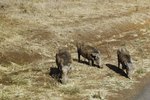
Yaks (Bos mutus) are bovids who live in India and China. In the past, they roamed throughout Bhutan and Nepal, where they are presently thought to be extinct. The species exists in both domesticated and wild forms, although only the wild specimens' numbers are falling. Yaks were previously considered an endangered species, and they now are tagged as vulnerable.
Yak Basics
Wild yaks inhabit isolated areas within the Tibetan Plateau, specifically grassy areas, steppes, deserts and tundras. Although they gravitate to grass, their living environments aren't always similar in terms of what kinds of plants are available. The habitats aren't always similar in terms of rainfall, either. Seasons sometimes determine where yaks choose to set up residence, too. They generally favor colder temperatures. Yaks spend a lot of time moving around in herds of their own genders. Males sometimes live independently or in tiny social units. When it comes time to reproduce, however, they promptly depart their units to go seek out females. Male yaks are typically extremely aggressive to each other in efforts to mate.
Unlawful Hunting
The yak population is dropping for numerous reasons, one of which is unlawful hunting. Yaks are often sought for their flesh. Male yaks are usually easier hunting targets than females are, likely due to their habits of leaving the females' usually hilly stomping grounds.
Domesticated Yaks
The presence of domesticated yaks is troubling to the future of wild yaks. When their domesticated counterparts employ their living environments, it pushes them out because of factors such as rivalry over grazing spaces. Wild yaks are sometimes made to retreat to even more elevated and difficult-to-reach mountainous landscapes. The possible exchange of illnesses between wild and domesticated yaks is also a dilemma. Also, breeding between domesticated and wild yaks is dangerous to their population's strengths. The differences between domesticated and wild yaks are easily apparent. Not only is their coloration different, the wild guys are also significantly bigger.
Protection
Despite being granted Chinese protection in 1962, the population of wild yaks continues to get smaller. Some yaks live in designated nature areas in China, including the Changtang and Arjin Shan reserves, for example. These areas aren't total safe havens against habitat minimization and hunting troubles, though. In 1995, the planet's total wild yak count was guessed to be around 15,000 individuals.
References
Photo Credits
-
David De Lossy/Digital Vision/Getty Images




